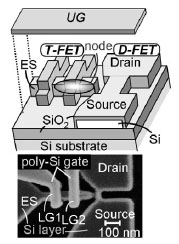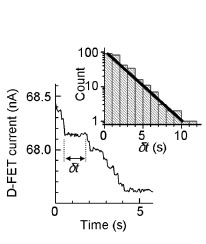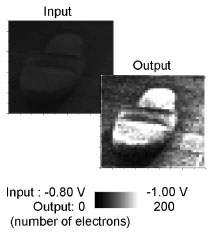Physical Science Laboratory
Stochastic resonance (SR) is a unique phenomenon that takes advantage
of noise to enhance the response of a system to a weak signal [1]. SR is
known to be beneficial in geographic and biological systems and has motivated
studies seeking to implement an SR function into electronic devices. However,
since noise is artificially superimposed on the devices, total system becomes
complicated and operation speed for SR is limited by the bandwidth of the
artificial noise spectrum. In this work, we demonstrate fast SR operation
utilizing shot noise originating from single-electron (SE) transfer in
nanowire transistors [2].
The device is composed of two transistors fabricated on a silicon-on-insulator
wafer (Fig. 1). The first transistor (T-FET) transfers single electrons.
An upper gate (UG) and lower gate (LG2) are used to induce an electron
source (ES) and electron-storage node. LG1 controls SE transfer from the
ES to the node in the same manner as that in the subthreshold regime of
a transistor, i.e., non-linear characteristics. The SEs transferred to
the MN are detected by the other transistor (D-FET) as shown in Fig. 2
[3]. An analysis of individual SE transports, in which the histogram of
interval δ t between each SE transport shows exponential decay (inset of Fig. 2), reveals
that SEs are transferred randomly to the node, which means shot noise in
the transistor. Since such non-linear characteristics and random transport
are fundamental in a transistor, they are available when δ t is on the order of nanoseconds or shorter, which allows fast SR.
When square waveforms as input signal Sin are applied to the ES and the differential of current flowing through
the D-FET is monitored as output signal Sout, the similarity (or correlation coefficient) between Sin and Sout becomes the maximum at the particular voltage applied to LG1. This means that shot noise originating from SE transport activates SR. On the other hand, when the number of electrons transferred to the node within the particular interval is also used as Sout, SR characteristics are confirmed even at the interval of 10 ns because
shot noise guarantees complete randomness of SE transport. SR utilizing
these features allows fast pattern perception: an input image with low
contrast is converted to an image with higher contrast (Fig. 3). Here,
Sin is extremely small so that Sout is represented by a few hundred electrons and the interval of each signal
input is 10 ns. Therefore, SR using SE-based shot noise is useful for single-shot
sensing of quickly moving targets.
[1] L. Gammaitoni et al., Rev. Mod. Phys. 70 (1998) 223.
[2] K. Nishiguchi and A. Fujiwara, Jpn J. Appl. Phys. 50 (2011) 06GF04.
[3] K. Nishiguchi et al., Jpn J. Appl. Phys. 47 (2008) 8305.
 |
 |
 |
||||||||
|
|
|